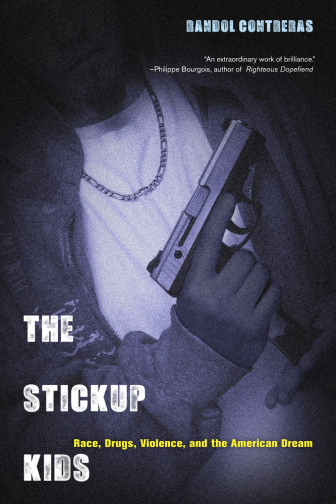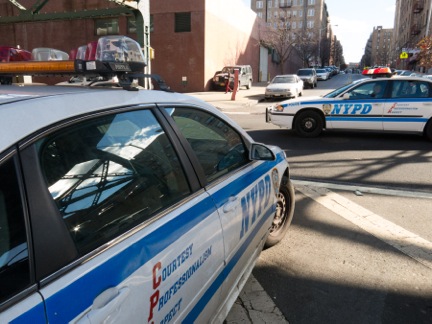
UC Press / http://www.ucpress.edu/book.php?isbn=9780520273382
His book "Stickup Kids: Race, Drugs, Violence and the American Dream," published by the University of California Press last month, chronicles the downfall of the drug trade and the young Dominican men from his childhood neighborhood that tried to make an often dangerous living in it.
It’s a personal story for Contreras. As teenagers, Contreras, now 41, writes that he and his friends grew up seeing the flashy Dominican drug dealers making money hand over fist and desperately wanted to be like them.
“I saw a lot of drug dealers living the high life,” he says. "It was time to make it, to achieve this grand American dream."
 But by the time they were old enough to take part, the market had dwindled. Contreras didn’t make it as a drug dealer, so he turned to academia. His work brought him back to the South Bronx to research what happened to his friends that stayed and made a go for it.
But by the time they were old enough to take part, the market had dwindled. Contreras didn’t make it as a drug dealer, so he turned to academia. His work brought him back to the South Bronx to research what happened to his friends that stayed and made a go for it.
Much of the time covered in the book was when Contreras lived in the area, off the 4 train’s 167th street stop, a few blocks from the new Yankee stadium. The area is full of public housing, industrial businesses and empty parking lots that fill up on game days. New attempts to bring the area to its former glory have included putting in playgrounds and park areas, but windows are still barred, graffiti and trash are at every corner and police are an omnipresent force. The book focuses on two friends and a few others — under the aliases Pablo, Gus, Neno, Topi and David — in their circle from this neighborhood and traces their drug careers from the start to the present day.
The crack trade peaked in New York between 1987 and 1989, so Contreras and his peers, who he calls "tail enders," teenagers in the late 1980s, were a little too young and too late to the game to be successful drug dealers. Soon robbing major drug dealers, despite the increased risk, became the lucrative move.
Contreras disagrees with other sociologists, specifically mentioning Jack Katz, a UCLA professor who contended in his book “Seductions of Crime: Moral and Sensual Attractions of Doing Evil” that people get into crime for the emotional allure, the thrill that comes with it. Contreras says while the thrill was part of it, it didn’t necessarily have to be crack. If teenagers thought they could grow up to be lawyers, the thrill could have come from arguing a court case. But crack dealing was what seemed possible for the neighborhood kids, and more importantly, it was a way to earn good money.
“If crack hadn't risen, there is a good chance they wouldn't have participated in the drug market,” he says. “Crack gave more opportunity for the youth to participate."
The South Bronx was built up for middle class families in the 1920s but by the time Contreras came of age it was becoming increasingly run-down with high-crime, low-employment and problem schools, and grinding down the population.
“The South Bronx was still on fire," he says.
The neighborhood still had plenty of people working legally, but the jobs were low-waged and dead end.
"They understood, intuitively, that they had little opportunity," Contreras says.
The Dominican drug dealers were a major exception to the trend, highly visible men that inspired envy. They had the nicest clothes, expensive cars and plenty of women. The dealers were the embodiment of the American Dream for the local children, Contreras said.
So even as the crack market started to shrink, the appeal of material wealth didn't fade. The city's officials might have celebrated the decline in crack, but it wasn't over for everyone.
"Once you get use to the high life," Contreras says. "It's hard to let it go."
The decline of crack use had the unintended consequence of driving up crime, even if it didn't show up in police reports. The stickup kids would hold up major drug dealers, the wholesalers, to keep up their lifestyles. Drug dealers, for obvious reasons, do not always report being robbed of their wares to the police.
So these stickup kids -- the ones who aren’t in jail or dead as they enter adulthood -- instead of aging out of crime like most men do as they enter their late-20s, found new opportunities to make money through violence. Still, Contreras says the violence was not nearly as bad or frequent as when they were selling drugs themselves.
Even when his subjects tried to start aboveboard businesses with the money earned from robbing dealers, there were problems. A criminal record and no experience in business frustrated most attempts at making a go at an honest living. One of his subjects he calls "Pablo" wanted to start a company, but asked Contreras to take a major role and become the face of the business. He wasn't comfortable with public speaking. The business fell apart and Pablo went back to drug dealing.
"They become self-destructive," Contreras says of his subjects as they grew up and got stuck in the violent rut they found themselves in.
Contreras compared their growing up to be stickup kids to high school sports stars, who peak early with no later in life success. Instead, it’s a cycle of violence and lock-up and no major material wealth as they start families of their own.
“It’s almost disorienting,” he says. “They can't make sense of their new lower status.”
His subjects’ outlooks are not bright, highlighted by the fact that he is unwilling to discuss them in detail with a federal investigation ongoing.
In his book, he summed up his observations of the rise and fall of the drug cycle New York went through in the late 1980s and 1990s as a Greek tragedy, unfolding in three acts.
“When a drug market rises, a struggling college student becomes a drug dealer; a tough kid, an enforcer; a poor building superintendent, a lookout; and a dishwasher, a drug kingpin. When a drug market expands, a mother mourns her dead dealer son; a dad laments his drug-using daughter; a child visits a parent imprisoned by the state. When a drug market peaks, an ill-affected sibling becomes a social worker; a storefront preacher, a community organizer; a stay-at-home mom, an after-school volunteer.”
And when that market starts to decline, the lingering aftermath in the community proves to be an improvement for few.
The book continues, “When a drug market fades, an ex-con is perpetually unemployed; a recovering female addict, forever humiliated; a New York City mayor, despite doing nothing special, applauded and praised.”
